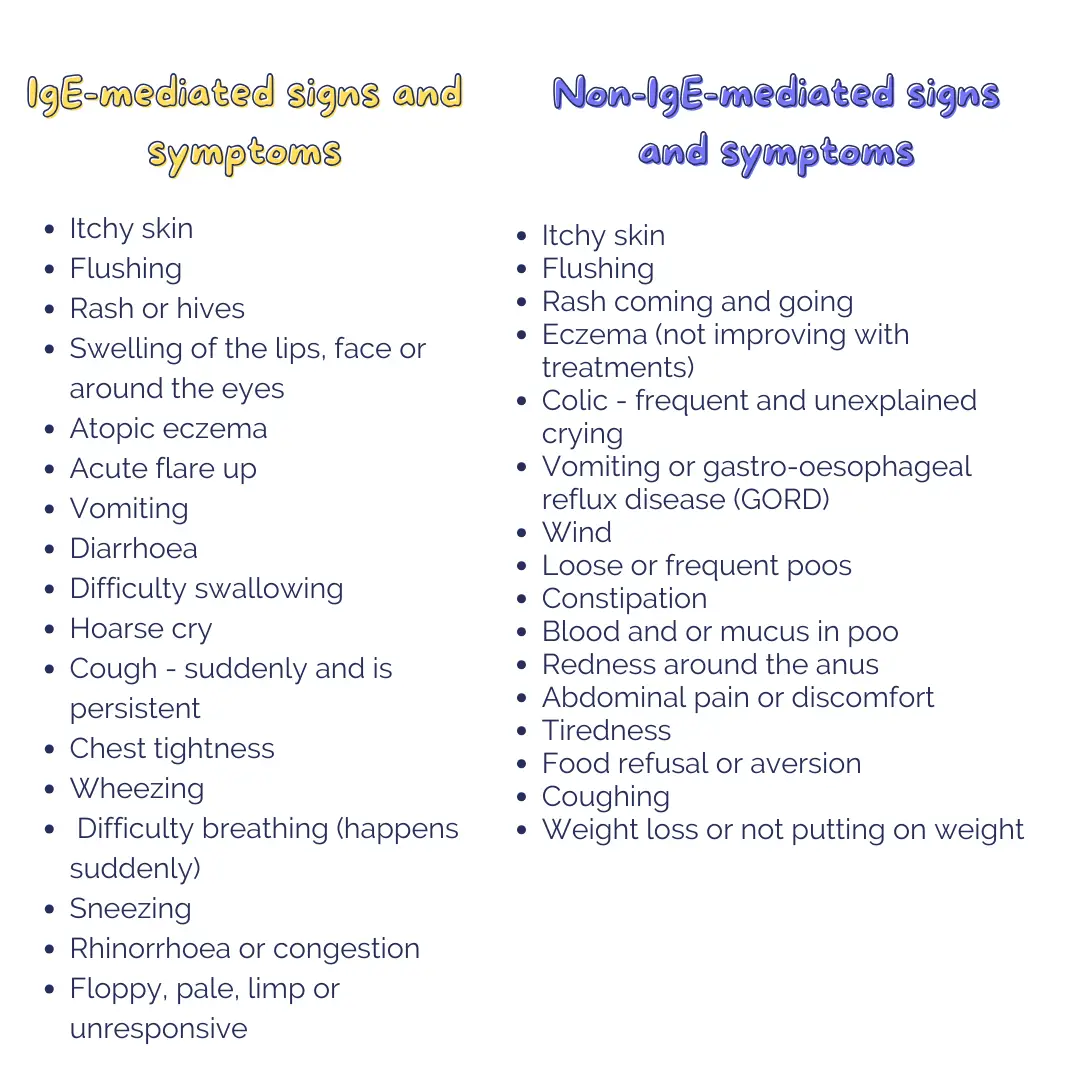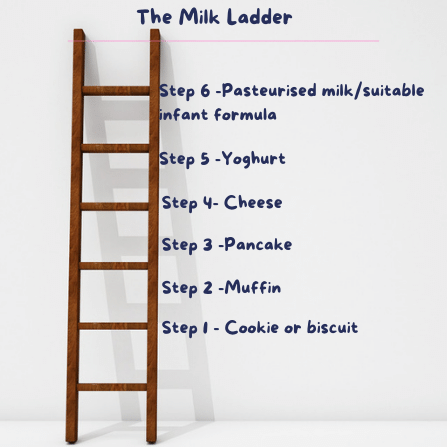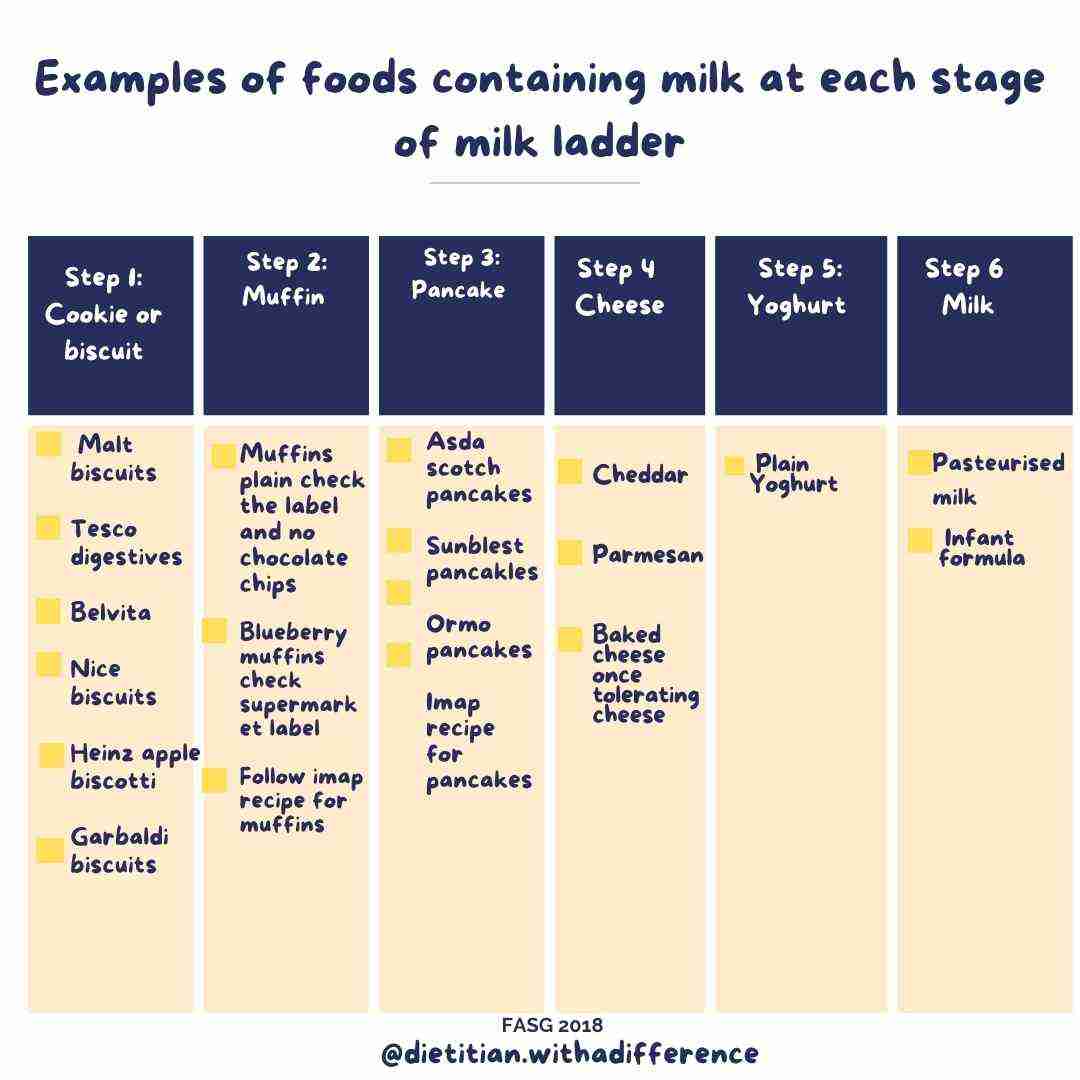Living with a milk allergy can be a daunting journey for both parents and their babies. Imagine the relief when you finally identify the culprit behind your little one’s discomfort – milk proteins. However, the journey doesn’t stop and there is understanding if the milk ladder is appropriate for your little one.
Understanding what parents of babies with cow’s milk allergies go through and their journey with the milk ladder (or the dairy ladder) is something I can really relate to. I’ve experienced this both in my professional work and on a personal level.
When my little girl was 12 months old, we made our first attempt at the milk ladder. We made it past step one and two of the dairy laddder and then couldn’t get any further. Let’s just say there was a lot of crying and vomiting, so we took a break.
After two more attempts and feeling like we would never enjoy birthday parties as a family, we finally made it to the top of the ladder when my daughter was three and a half… although – between you and me – she still flatly refuses cow’s milk, claiming she can’t have it, despite happily eating ice cream and chocolate milkshakes!
In this comprehensive guide, we will look into the topic of navigating the milk ladder, offering insights and practical advice for parents of babies with milk allergies.
What is a cow’s milk allergy?
Cow’s milk protein allergy (CMPA) is an abnormal response by the body’s immune system in which the proteins in cow’s milk are recognised as a potential threat. It is estimated to affect around 7% of babies under the age of one, although most children grow out of it by the age of five (1).
There are two main types of CMPA:
· IgE-mediated: typically rapid onset (within minutes and up to two hours after ingestion)
· Non-IgE-mediated: typically delayed onset (usually two to 72 hours after ingestion)
These two different types of allergies come with similar but slightly different signs and symptoms.
CMPA Symptoms

This list of cmpa signs and symptoms is not complete and if your child has other symptoms that does not mean your child doesn’t have a food allergy. Please consult with your medical professional if you are concerned (3).
What to do if you think your child has CMPA?
If you think your baby is having a reaction to cow’s milk then you should go and see your GP to discuss your concerns. They will assess your baby’s symptoms to see if it could be a cow’s milk allergy. Make sure you get medical advice before taking cow’s milk out of your child’s diet.
Ideal Age to Begin the Milk Ladder
Timing is a crucial factor when embarking on the milk ladder journey. While there isn’t a one-size-fits-all answer, it is recommended to start around 9 to 18 months. It is recommended to follow a milk-free diet for 6 months after diagnosis. However, it’s essential to remember that every baby is unique, and factors like their individual development and overall health should guide your decision.
Ensuring Baby’s Good Health
One of the golden rules of the milk ladder journey is to only start when your baby is in good health. This means that your baby should be free from any ongoing illnesses or infections. Introducing potential allergens during a time of illness could lead to confusion when assessing reactions and symptoms. Therefore, it’s wise to wait until your little one is feeling their best before taking those first steps on the milk ladder.
Considerations for Breastfeeding Mothers
If you’re breastfeeding your baby, you’ll find that your diet plays a significant role in their exposure to potential allergens, including dairy proteins. As you embark on the milk ladder, it’s essential to remember that the foods you consume can influence your breast milk composition.
As a paediatrian dietitian I advise starting with the milk ladder with your baby first. Starting the milk ladder with your baby allows you to focus on your baby’s tolerance development without any outside variables. This initial step helps you closely monitor their reactions, understand their sensitivities, and ensure that the reintroduction of milk proteins is gradual and controlled.
Hypoallergenic Formula and the Milk Ladder
The decision of whether to continue hypoallergenic formula while starting the milk ladder depends on the individual circumstances of your baby. If your baby is under 12 months old it is important to continue witht formula.
However, after 12 months they may no longer need the formula if they are growing well. They can switch to an alternative dairy free milk at 12 months like e.g. oat or soya milk. Have a look at my blog on oat milk to see the best alternative options.
The 6-Step or 12-Step Ladder?
When embarking on the milk ladder journey, one decision you’ll need to make is whether to follow the 6-step or 12-step ladder. Each approach has its own set of advantages and disadvantages, and the choice you make should be informed by various factors to ensure the best outcome for your baby.
Comparing the 6-Step and 12-Step Milk Ladders
6-Step Milk Ladder:
Advantages:
- Simplified Process: The 6-step ladder offers a more streamlined approach, with fewer stages to navigate.
- Faster Progression: Since there are fewer steps, the process generally moves along more quickly, potentially leading to a shorter duration of the milk ladder journey.
Disadvantages:
- Rapid Exposure: The quicker progression might mean your baby is exposed to higher levels of milk proteins sooner, which could increase the risk of reactions.
12-Step Milk Ladder:
Advantages:
- Gradual Exposure: Taking things step by step: the 12-step ladder goes slowly, giving your baby’s immune system more time to get used to things.
Disadvantages:
- Prolonged Journey: Due to the increased number of steps, the 12-step ladder might extend the overall duration of the process.
- More Complex: Managing a higher number of stages can be more challenging for parents, potentially leading to confusion or missteps.
Personally with my little girl we followed the 12 step ladder, however, this was before the 6 step ladder was introduced. It normally advise following the 6 step milk ladder.
Regular communication with a paediatric dietitian is vital to monitor your baby’s responses, make adjustments as needed, and ensure that the chosen ladder length works with their specific needs.
What is the Milk Ladder?

The Milk Ladder (dairy ladder) is a technique of reintroducing your child to cow’s milk slowly so that their tolerance builds gradually. It is only suitable for children with mild to moderate non-IgE-mediated allergies, and you should always seek medical advice before attempting the Milk Ladder.
The Milk Ladder is a six step process, and I recommend referring to the official imap milk ladder ( iMAP guide) for details. It includes sweet and savoury recipes too.
Put simply, the Milk Ladder starts with more broken down forms of milk, like biscuits or pancakes, and builds up to things like yoghurt and cheese, until eventually your child can have milk. This is because when milk is heated or baked, the protein changes so it is less allergenic.
6 Steps of the Milk ladder
Here is an overview of the steps, but please do refer to the official guidance and remember to always speak to your dietitian about it first:
· Step 1: Malted milk biscuit or cookie that contains milk as an ingredient. Start with just one and build up to three per day by day seven
· Step 2: A muffin that contains milk (you can find recipes via the iMAP guide). Start with half and build up to a whole muffin.
· Step 3: A pancake that contains milk. Start with half and build up to a whole pancake a day.
· Step 4: 15g of hard cheese and build up to baked cheese, e.g. on pizza.
· Step 5: Aim to build up to 125g of yoghurt.
· Step 6: Pasteurised milk or suitable infant formula. Start with 100ml mixed with current formula and aim for 200ml.
If your child has a reaction at any of the steps please stop and contact your dietitian before starting again. Once you have reached the top of the ladder switch to cow’s milk in all food and cereals at breakfast.
Recognising Reactions on the Milk ladder
Going through the milk ladder journey means you need to be careful to notice if your baby has any allergies when you give them milk foods again. Being able to tell if these reactions are happening is super important to keep your baby safe and healthy.
Identifying Allergic Reactions
Allergic reactions can vary in intensity, ranging from mild to severe. Here are some common symptoms to watch out for during the milk ladder journey:
- Skin: Rashes, hives, eczema flare-ups, redness, and itching.
- Digestive: Vomiting, diarrhoea, abdominal pain, bloating, or gas.
- Respiratory: Sneezing, coughing, wheezing, nasal congestion, or runny nose.
- General: Irritability, fussiness, excessive crying, or changes in sleep patterns.
Pausing or Adjusting the Ladder
Should you notice any of these symptoms, it’s crucial to act promptly. If the reaction is mild, you might consider pausing the ladder temporarily and going back to the previous step for a longer duration before attempting to progress again. If the reaction is more severe, such as difficulty breathing or swelling of the face, lips, or tongue, seek immediate medical attention.
Importance of Clear Communication
Maintaining open and clear communication with your paediatric dietitian is paramount during the milk ladder journey. Regularly updating them on your baby’s progress, symptoms, and reactions allows them to provide timely guidance. They can help you interpret the signs of reactions and recommend appropriate adjustments to the ladder’s pace or specific foods.
Keeping a Reaction Diary
Keeping a detailed reaction diary can be really helpful. Record the foods introduced, the corresponding ladder step, and any observed symptoms. This documentation serves as a valuable resource for both you and your paediatric dietitian, aiding in the assessment of your baby’s progress and helping to identify any patterns in their reactions.
Duration of Each Step
One of the critical aspects of successfully navigating the milk ladder journey is understanding how long you should stay on each step of the ladder. This phase is a delicate balance between gradually exposing your baby to milk proteins and allowing their immune system to adapt.
Milk ladder how long on each step
The duration of each step on the milk ladder can vary widely, and there isn’t a one-size-fits-all answer. Generally, parents should aim to stay on each step for several days to a week, depending on their baby’s individual response. This timeline allows you to observe your baby’s reactions and gauge their tolerance level accurately.
Factors Influencing the Duration
Several factors influence how long you should stay on each step:
- Symptom Progression: If your baby is tolerating a step well and showing no signs of allergic reactions, you might consider progressing more quickly. Conversely, if they experience mild symptoms, it’s advisable to extend the duration on that step.
- Severity of Allergy: Babies with more severe allergies might require longer periods at each step to ensure their immune system safely adapts to increasing levels of milk proteins.
- Tolerance Patterns: Observing how your baby’s body responds at each stage helps you determine whether they need more time to build tolerance before moving forward.
- Consultation with a Dietitian: Paediatric dietitians play a crucial role in guiding you on the appropriate duration for each step. Their expertise helps you tailor the journey to your baby’s unique needs.
My little girl took 3.5 years to reach the top of the milk ladder! We were stuck for years on the lower steps. So don’t despair. Most children by the time they are school age will grow out of a non ige milk allergy.
Dealing with Refusal of Foods on the Steps
Encountering food refusal from your baby during the milk ladder journey is not uncommon and can pose a challenge. If your little one is showing resistance to certain foods like malt biscuits or specific recipes, don’t be disheartened.
Remember that each baby has their own taste preferences and sensitivities. If malt biscuits aren’t a hit, you can explore alternatives like Heinz apple biscotti biscuits or get creative by incorporating the biscuits into dairy-free yogurt, creating a creamy and textured treat.
The key is to remain patient and adaptable, understanding that there’s no one-size-fits-all solution. As you navigate this journey, keep an open line of communication with your paediatric dietitian. They can provide tailored advice, suggest alternatives, and help you find ways to maintain the gradual reintroduction of milk proteins while accommodating your baby’s preferences.

In conclusion, remember that every baby’s experience on the milk ladder is unique, and there’s no one-size-fits-all approach. If you are struggling with CMPA or about to start the cmpa milk ladder and would like more support check out my consultation package or download my FREE guide on cow’s milk allergy weaning guide

“Dietitian with a Difference” holds no liability for any adverse reactions that may arise from the implementation of the milk ladder. It is imperative that the milk ladder is undertaken exclusively under the guidance and supervision of a registered dietitian. The content provided is for informational purposes only and does not replace professional medical advice.
